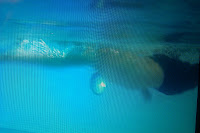Novice and Expert Videos-
The following videos show an expert and a novice executing the backstroke swimming position.
Due to camera angles, poor equipment and excessive instability of hand recorded videos the following animation is provided below. This animation is perhaps the best representation for the proper execution of the freestyle stroke due to its stability and ability to provide all aspects of movement clearly.
Phases of Backstroke Swimming












Upper Body-
1. Initial Position Phase
In order to proper execution of the backstroke, the swimmer must begin in a supine position. For the initial position the glenohumeral joint of the shoulder must be flex and slightly externally rotate with the elbow completely extended. At this point the fifth phalange should be inferior to the first digit and in contact with the water.
2. Catch Phase
Catch phase (first part of the power phase). The arm and hand enters downward starting with the fifth metatarsal first then flexing slightly at the elbow catching the water while moving anteriorly with the phalanges adducted.
3. Mid Pull Phase
Once the catch is made the flexed elbow should move anteriorly pulling the body through the water and extending simultaneously to end up at the side of the body.
4. Finish Phase
During the finish phase, the forearm should pronate and begin to come out of the water with the fifth metatarsal first ready to continue to the recovery phase.
5. Recovery Phase
The recovery phase consists of the final semi circle returning the hand to it's original position superior to the head.
Lower Body-
Coordination between upper body and lower body is key to successful execution of all swimming strokes. I have separated upper body and lower body to explain the steps within the stroke for the lower body. *Do not execute upper body and lower body movements at different times, if you observe the videos provided you can see how simultaneously the upper and lower body work together for fluid movement* The low body moves mostly using the main joints of the ankle which include the subtalar joint and talocrural joint.
1. Hip Movement
Many swimmers flex their tibio-femoral joint along the too much while kicking this is considered kicking from the knee. This creates large amounts of drag and causes swimmer's legs to sink low in the water. Instead of kicking from the knee you should kick from the hip with a relatively extended leg. You should keep your legs extended and move them simultaneously up and down. It is best not to think about flexingyour knee at all, instead think about kicking from the hip at the iliofemoral joint with an extended leg and a very slight flexion of the knee will happen naturally.
2. Foot Movement
When you swim you should always have your ankle plantar flexed. Not pointing your toes down and keeping the ankle in dorsi-flexion will push water anteriorly when you kick, slowing your velocity dramatically.
* Rotation of the entire body when swimming backstroke it essential*
Common Mistakes:
Unnecessary movement of the head, slap back of hand to water, failing to flex the elbow and not rotating body.
Cue:
Look up at ceiling, flex elbow and rotate body.
One-Arm Backstroke Drill
This drill focuses on body roll, rotating shoulders and hips together, and developing strength with a deep pull.
-Hold the right arm at your side next to your body and swim 25 using just the left arm. Focus on rolling to your left during the pull and back to the right during the recovery.
-Switch arms (left arm at your side and pull with the right arm) and swim back. Focus on rolling to your right during the pull and back to the left during the recovery.























